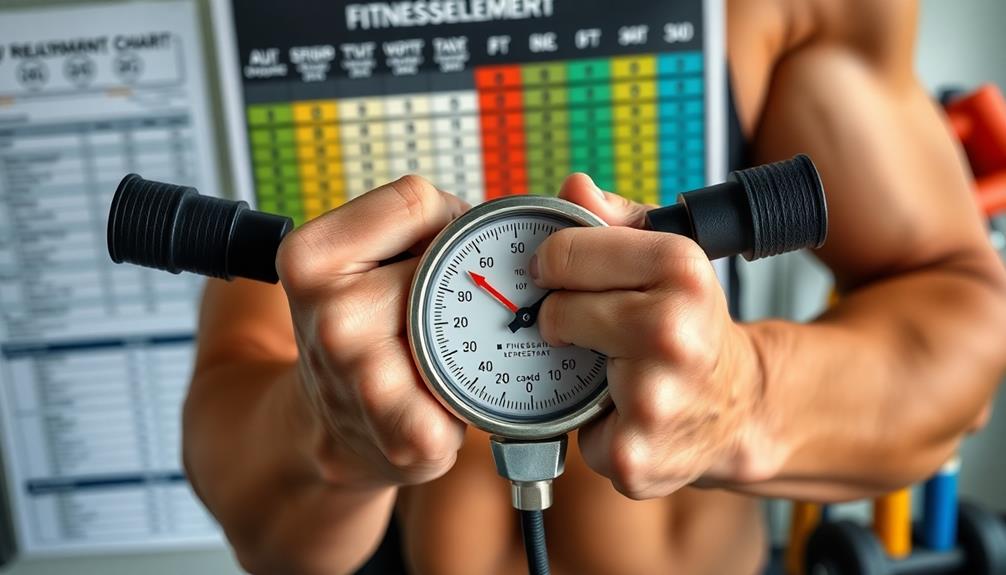To effectively use resistance exercises for injury prevention, start by evaluating your current fitness level and setting realistic goals. Choose appropriate equipment like resistance bands or dumbbells, and focus on proper form and technique. Implement progressive overload principles to gradually increase difficulty. Target injury-prone areas such as the lower back, shoulders, knees, and ankles with specific exercises. Balance strength training with flexibility work, incorporating stretches and mobility exercises. Prioritize recovery and rest, ensuring adequate sleep and nutrition. Integrate resistance training with other exercise modalities for a well-rounded approach. By following these strategies, you'll build a more resilient and injury-resistant body.
Core Insight
- Focus on proper form and technique to minimize strain and maximize benefits.
- Target injury-prone areas like lower back, shoulders, knees, and ankles with specific exercises.
- Gradually increase intensity using progressive overload principles to build strength safely.
- Balance strength training with flexibility exercises to improve overall joint stability and mobility.
- Incorporate adequate rest and recovery strategies to prevent overuse injuries and promote muscle repair.
Understanding Resistance Training Benefits

Resistance training is a powerful way to prevent injuries. It makes your muscles, tendons, and ligaments stronger, giving you a more resilient body. When you work out with weights or resistance bands, you build strength and improve joint stability and bone density. Resistance bands are a great choice for home workouts because they offer many options for different fitness levels and exercise types.
Resistance training helps your body absorb shock better and keeps your form in check during daily activities. It fixes muscle imbalances that might cause injuries and makes your posture better overall. You'll also have better body awareness and coordination, which can help you avoid accidents.
Doing resistance exercises regularly boosts your metabolism, which helps with weight management. This is important for preventing injuries because extra weight puts more stress on your joints. By making resistance training a part of your routine, you're investing in your long-term health and lowering your chances of getting hurt in the future.
Assessing Your Current Fitness Level

Before starting a resistance training program, take some time to evaluate your current fitness level. This helps you set realistic goals and choose the right exercises. Consider your strength, flexibility, and cardiovascular endurance. A fitness professional can give you a thorough assessment, which may include:
- Measuring body fat and muscle mass
- Testing muscular strength and endurance
- Checking flexibility
- Evaluating cardiovascular fitness
When choosing resistance tubes, think about your fitness level and what you want to achieve. Resistance levels range from 2 lbs to over 40 lbs. If you're new to exercise or recovering from an injury, start with lower resistance. If you want to build strength, go for higher resistance.
Use your assessment results to create a resistance training program that meets your needs. Everyone starts at a different point, and that's fine. Choose exercises that suit your fitness level, and set goals you can reach. Reassess your fitness regularly to track progress and make changes to your program as needed. This will help you keep improving your fitness and avoid injuries.
Choosing the Right Equipment

When choosing equipment for resistance exercises, pick items that match your fitness level and goals. Resistance bands are a good start because they're versatile and great for beginners. As you get stronger, consider adding dumbbells or kettlebells to your routine. These free weights let you do many different exercises and can be easily adjusted as you progress. Bow trainers are a unique and effective option for improving archery skills while working on overall fitness.
For bodyweight exercises, get a good exercise mat and maybe a pull-up bar. If you want to build more serious strength, a barbell set with weight plates could work. Keep in mind your available space and budget when making your choices. Don't feel like you have to buy everything at once; you can gradually add to your collection as your fitness journey continues.
Proper Form and Technique

Proper form and technique are key for safe, effective resistance training. They help you get the most from your workouts while lowering your risk of injury. To do exercises right, remember to:
- Keep your spine straight
- Tighten your core for balance
- Go slow and steady when lifting and lowering weights
- Breathe evenly, breathing out when pushing or pulling
Use light weights at first to get the form down before trying heavier ones. Move through the full motion for each exercise, but don't overdo it. Watch how your body lines up, especially with machines or free weights. A trainer can help check your technique if needed. Focus on doing reps correctly over just doing a lot. Infrared heat pads after tough workouts can ease sore muscles so you recover faster and stay consistent with training.
Progressive Overload Principles

Progressive overload helps you get stronger and avoid injuries. To use progressive overload, slowly make your exercises harder over time. You can change:
- Weight: Add 5-10% more weight to build strength
- Reps: Do 1-2 more reps each set to improve endurance
- Sets: Go from 3 sets to 4 for more volume
- Frequency: Work out 3 times a week instead of 2 to adapt faster
- Tempo: Go slower on the eccentric phase for more time under tension
Using proper form is key, but progressive overload keeps your gains coming.
Targeting Injury-Prone Areas

Injury prevention requires focusing on areas that often get injured. These are usually joints and muscles that experience a lot of stress during day-to-day activities or sports. Strengthening these areas boosts their resilience and lowers the chance of injury. The main injury-prone areas to concentrate on are:
- Lower back
- Shoulders
- Knees
- Ankles
When creating your resistance training plan, include exercises that target these vulnerable spots. For instance, do deadlifts and planks for your lower back, rotator cuff exercises for shoulders, squats and lunges for knees, and calf raises for ankles. Resistance tubes with different levels of resistance are great for targeting these areas while letting you customize and progress. Start with lighter weights and proper form, slowly increasing intensity as you get stronger. By focusing on these injury-prone areas, you'll develop a more balanced and resilient body overall.
Balancing Strength and Flexibility

Balancing strength and flexibility is key for preventing injuries. To do this, focus on both aspects in your training. Start with exercises like squats and deadlifts to build strength in multiple muscles. Massage balls can help your muscles recover between workouts.
Next, add in flexibility work. Do dynamic stretches before working out and static stretches after. Mobility exercises that combine strength and flexibility, like lunges with rotation, are also great.
Recovery and Rest Strategies

Three easy ways to help your body recover after resistance training are:
- Get enough sleep, at least 7-9 hours a night. Sleep is when your body repairs and rebuilds muscle.
- Do low-intensity activities like walking or swimming on rest days. This is called active recovery.
- Eat enough protein and drink plenty of water. Good nutrition supports muscle recovery.
Foam rolling can also help relax tight muscles and improve blood flow for faster recovery. It works well on big muscle groups.
Other tips:
- Use a foam roller or get a massage to relax muscles
- Take regular deload weeks with less training
- Stretch to stay flexible
- Pay attention to your body and adjust workouts if needed
Integrating With Other Exercise Modalities

Resistance training is just one part of preventing injuries. For the best results, mix it up with other types of exercise too. Cardio, stretching, and balance training are all important pieces of the puzzle.
Resistance tubes are a great choice for strength training. They're easy to use anywhere and come in different resistance levels from light to heavy.
Cardio exercises like running, swimming, or biking help you build endurance and keep your heart healthy. They also help you stay at a healthy weight, which means less stress on your joints. Stretching improves flexibility and range of motion, lowering your chances of getting hurt during physical activities. Balance exercises, like standing on one leg or using a stability ball, improve your body control and awareness.
Frequently Asked Questions
Can Resistance Training Help With Chronic Conditions Like Arthritis or Osteoporosis?
Yes, resistance training can help with chronic conditions like arthritis and osteoporosis. You'll strengthen muscles, improve joint stability, and increase bone density. It's important to start slowly and consult your doctor before beginning any new exercise program.
Are There Age Restrictions for Starting a Resistance Training Program?
You can start resistance training at any age, but consult your doctor first. It's never too late to begin, and you'll benefit from tailored programs. Start slowly, focus on proper form, and gradually increase intensity as you progress.
How Long Does It Typically Take to See Injury Prevention Benefits?
You'll typically notice injury prevention benefits from resistance training within 4-8 weeks. However, you're strengthening your body from the first session. Consistency's key, so stick with it and you'll see improvements in stability and strength over time.
Can Resistance Exercises Be Done During Pregnancy for Injury Prevention?
Yes, you can do resistance exercises during pregnancy for injury prevention. However, you'll need to consult your healthcare provider first. They'll help you modify exercises to suit your stage of pregnancy and guarantee your safety.
Are There Specific Resistance Exercises for Preventing Sports-Related Injuries?
Yes, there are specific resistance exercises for preventing sports-related injuries. You'll want to focus on exercises that target common injury areas in your sport, such as strengthening rotator cuffs for swimmers or improving knee stability for runners.

